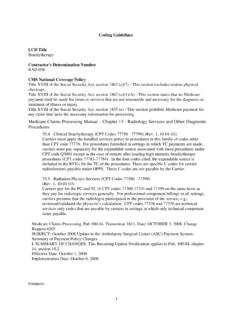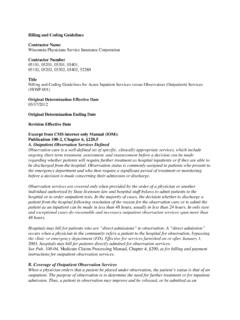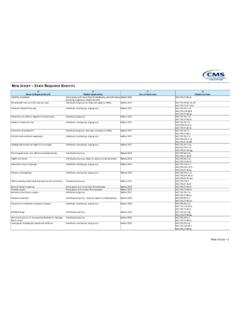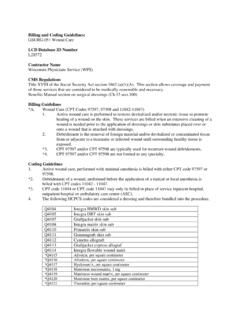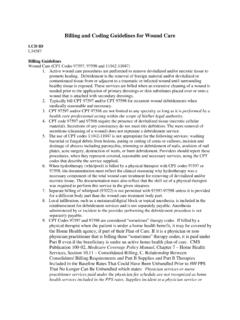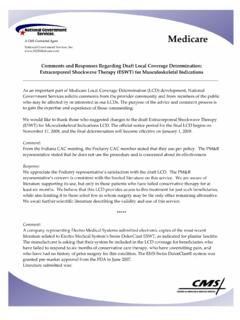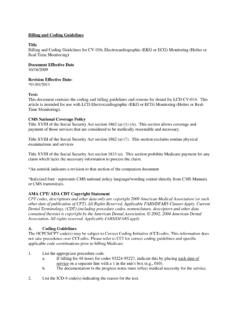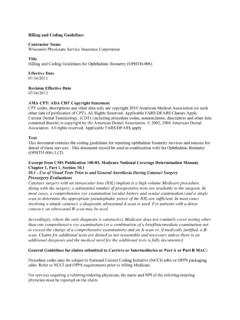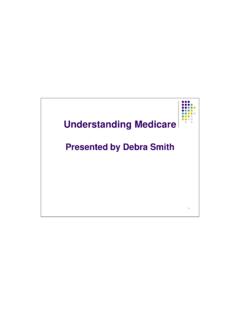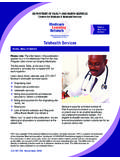Transcription of Billing and Coding Guidelines - CMS
1 Billing and Coding Guidelines Contractor Name Wisconsin Physicians Service Insurance Corporation Contractor Number 05101, 05201, 05301, 05401, 05102, 05202, 05302, 05402, 52280 Title Billing and Coding Guidelines for Acute Inpatient Services versus Observation (Outpatient) Services (HOSP-001) Original Determination Effective Date Original Determination Ending Date Revision Effective Date Excerpt from CMS internet only Manual (IOM): Publication 100-2, Chapter 6, A. Outpatient Observation Services Defined Observation care is a well-defined set of specific, clinically appropriate services, which include ongoing short term treatment, assessment, and reassessment before a decision can be made regarding whether patients will require further treatment as hospital inpatients or if they are able to be discharged from the hospital. Observation status is commonly assigned to patients who present to the emergency department and who then require a significant period of treatment or monitoring before a decision is made concerning their admission or discharge.
2 Observation services are covered only when provided by the order of a physician or another individual authorized by State licensure law and hospital staff bylaws to admit patients to the hospital or to order outpatient tests. In the majority of cases, the decision whether to discharge a patient from the hospital following resolution of the reason for the observation care or to admit the patient as an inpatient can be made in less than 48 hours, usually in less than 24 hours. In only rare and exceptional cases do reasonable and necessary outpatient observation services span more than 48 hours. Hospitals may bill for patients who are direct admissions to observation. A direct admission occurs when a physician in the community refers a patient to the hospital for observation, bypassing the clinic or emergency department (ED). Effective for services furnished on or after January 1, 2003, hospitals may bill for patients directly admitted for observation services.
3 See Pub. 100-04, Medicare Claims Processing Manual, Chapter 4, 290, at for Billing and payment instructions for outpatient observation services. B. Coverage of Outpatient Observation Services When a physician orders that a patient be placed under observation, the patient s status is that of an outpatient. The purpose of observation is to determine the need for further treatment or for inpatient admission. Thus, a patient in observation may improve and be released, or be admitted as an inpatient (see Pub. 100-02, Medicare Benefit Policy Manual, Chapter 1, 10 Covered Inpatient Hospital Services Covered Under Part A. C. Notification of beneficiary All hospital observation services, regardless of the duration of the observation care, that are medically reasonable and necessary are covered by Medicare, and hospitals receive OPPS payments for such observation services.)
4 A separate APC payment is made for outpatient observation services involving three specific conditions: chest pain, asthma, and congestive heart failure (see the Medicare Claims Processing Manual, ) for additional criteria which must be met. Payments for all other reasonable and necessary observation services are packaged into the payments for other separately payable services provided to the patient on the same day. An ABN should not be issued in the context of reasonable and necessary observation services, whether packaged or paid separately. If a hospital intends to place or retain a beneficiary in observation for a noncovered service, it must give the beneficiary proper written advance notice of noncoverage under limitation on liability procedures (see Pub. 100-04, Medicare Claims Processing Manual; Chapter 30, Financial Liability Protections, 20, at for information regarding Limitation On Liability (LOL) Under 1879 Where Medicare Claims Are Disallowed).
5 Noncovered, in this context, refers to such services as those listed in paragraph D, below. D. Services That Are Not Covered as Outpatient Observation The following types of services are not covered as outpatient observation services: Services that are not reasonable or necessary for the diagnosis or treatment of the patient. Services that are provided for the convenience of the patient, the patient s family, or a physician, ( , following an uncomplicated treatment or a procedure, physician busy when patient is physically ready for discharge, patient awaiting placement in a long term care facility). Services that are covered under Part A, such as a medically appropriate inpatient admission, or services that are part of another Part B service, such as postoperative monitoring during a standard recovery period, ( , 4-6 hours), which should be billed as recovery room services.
6 Similarly, in the case of patients who undergo diagnostic testing in a hospital outpatient department, routine preparation services furnished prior to the testing and recovery afterwards are included in the payment for those diagnostic services. Observation should not be billed concurrently with therapeutic services such as chemotherapy. Standing orders for observation following outpatient surgery. Ex Claims for the preceding services are to be denied as not reasonable and necessary, under 1862(a)(1)(A) of the Act. Billing and Coding Guidelines Inpatient Acute, inpatient care is reimbursed under a diagnosis-related groups (DRGs) system. DRGs are classifications of diagnoses and procedures in which patients demonstrate similar resource consumption and length-of-stay patterns. A payment rate is set for each DRG and the hospital s Medicare reimbursement for an inpatient stay is based on that rate.
7 Length of stay is not a factor and the hospital receives the same DRG payment whether the patient stays one day or several days. Medical necessity for inpatient care is based upon and determined by the physician s assessment of the patient s history and physical (H & P) and specific risk factors that are inherent to the beneficiaries condition at the time of admission. 3-Day Window Payment 3-payment window includes all outpatient diagnostic services and non-diagnostic services related to the inpatient stay On the date of inpatient admission, or 3 days immediately preceding the date of admission Unless the hospital demonstrates that such services are not related to such admission Statute does not change the Billing of diagnostic services Hospitals are able to bill correctly for admission-related outpatient non-diagnostic services without modifying dates on the inpatient claim bundle services on the inpatient hospital claim ICD-9-CM procedure code dates for non-diagnostic services will be allowed Inpatient Changed to Outpatient The hospital Conditions of Participation (CoP) at 42 CFR ) and ( CoP) at 42 (c).
8 Require hospitals to have a utilization review (UR) plan. A UR plan is defined as a formal evaluation of the coverage, medical necessity, efficiency, or appropriateness of health care services and treatment plans for an individual patient. Hospital must ensure all the UR requirements are fulfilled Hospital UR committees consist of two or more practitioners. Code 44 Process for Inpatient Turned to Outpatient 1 The determination that an admission or continued stay is not medically necessary may be made by one member of the UR committee, provided the practitioner responsible for the care of the patient either concurs with the determination or fails to present his or her view when afforded the opportunity. 2. In all other cases two members of the UR committee must determine that the inpatient admission is not medically necessary. If two physician members of the UR committee determine the patient s stay is not medically necessary, their decision becomes final 3.
9 CMS has determined that only those licensed practitioners, authorized under state law to admit patient s to the hospital have the authority to change a Medicare patient s status from inpatient to outpatient. 4. The UR committee must consult with the practitioner(s) responsible for the care of the patient and allow them to present their views before making the determination 5 If the UR committee determines the admission is not medically necessary, the committee must give written notification, no later than 2 days after the determination, to the hospital, the patient, and the practitioner responsible for the care of the patient. 6 It is the hospital UR committee that changes the beneficiary s status from inpatient to outpatient Use of Condition Code 44 Condition Code 44 is used when a decision to change a patient s status from inpatient to outpatient has been made.
10 Condition Code 44 requires all of the following components are met: The change of status is made prior to discharge and while still the patient is still in the hospital. The hospital has not submitted an inpatient claim for the services. A physician agrees with the UR committee s decision, and that physician is either the attending physician or the second member of the UR Committee. The physician s concurrence is documented in the patient s medical record. Condition Code 44 is not a substitute for adequate staffing or continued education of hospital existing policies and admission protocols that include review of medical necessity admissions and continued stays. Review of admissions may be performed before, at, or after hospital admission Excerpt from CR 6626, CMS Pub 100-04, Chapter 1, Section : Patients are admitted to the hospital as inpatients only on the recommendation of a physician or licensed practitioner permitted by the State to admit patients to a hospital.
